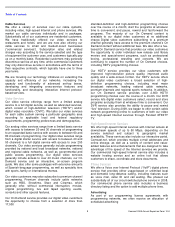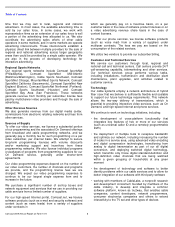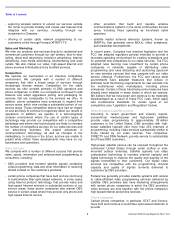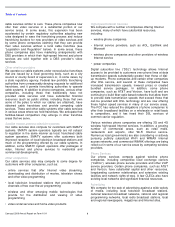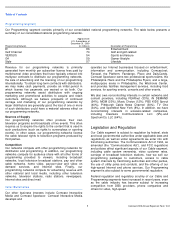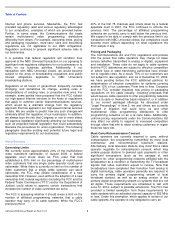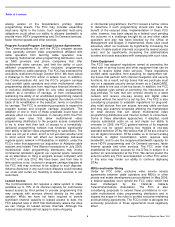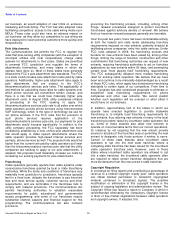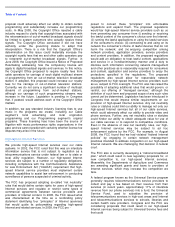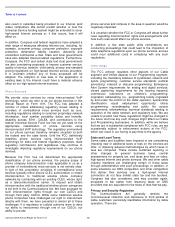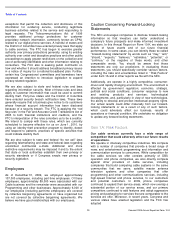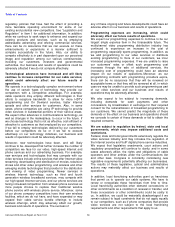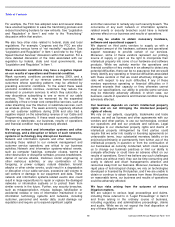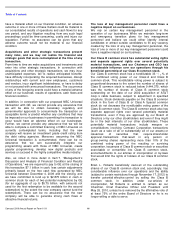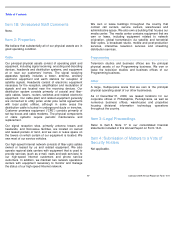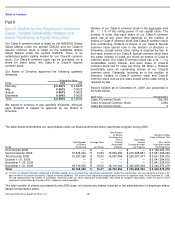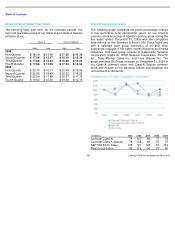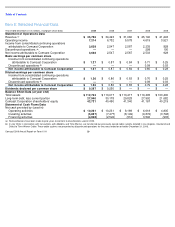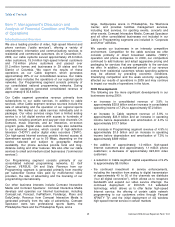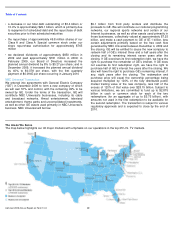Comcast 2009 Annual Report Download - page 18
Download and view the complete annual report
Please find page 18 of the 2009 Comcast annual report below. You can navigate through the pages in the report by either clicking on the pages listed below, or by using the keyword search tool below to find specific information within the annual report.
Table of Contents
Comcast 2009 Annual Report on Form 10-K
12
also result in subsidies being provided to our Internet (and
video) competitors. We cannot predict whether or how the
Universal Service funding system might be extended to cover
high-speed Internet services or, if that occurs, how it will
affect us.
In addition, Congress and federal regulators have adopted a
wide range of measures affecting Internet use, including, for
example, consumer privacy, consumer protection, copyright
protection, defamation liability, taxation, obscenity and
unsolicited commercial e-mail. State and local governments
have also adopted Internet-related regulations. Furthermore,
Congress, the FCC and certain state and local governments
are also considering proposals to impose customer service,
quality of service, taxation, child safety, privacy and standard
pricing regulations on high-speed Internet service providers.
It is uncertain whether any of these proposals will be
adopted. The adoption of new laws or the application of
existing laws to the Internet could have a material adverse
effect on our high-speed Internet business.
Phone Services
We provide voice services by using interconnected VoIP
technology, which we refer to as our phone services in this
Annual Report on Form 10
-K. The FCC has adopted a
number of orders addressing regulatory issues relating to
providers of nontraditional voice services such as ours,
including regulations relating to customer proprietary network
information, local number portability duties and benefits,
disability access, E911, CALEA, and contributions to the
federal Universal Service Fund, but has not yet ruled on the
appropriate classification of phone services using
interconnected VoIP technology. The regulatory environment
for our phone services therefore remains uncertain at both
the federal and the state levels. Until the FCC definitively
classifies phone services using interconnected VoIP
technology for state and federal regulatory purposes, state
regulatory commissions and legislatures may continue to
investigate imposing regulatory requirements on our phone
services.
Because the FCC has not determined the appropriate
classification of our phone services, the precise scope of
phone company interconnection rules applicable to us as a
provider of nontraditional voice services is not entirely clear.
In light of this uncertainty, providers of nontraditional voice
services typically either secure CLEC authorization or obtain
interconnection to traditional wireline phone company
networks by contracting with an existing CLEC, whose right,
as a telecommunications carrier, to request and obtain
interconnection with the traditional wireline phone companies
is set forth in the Communications Act. We have arranged for
such interconnection rights through our own CLECs and
through third party CLECs. While some traditional wireline
phone companies have challenged our right to interconnect
directly with them, we have prevailed in almost all of these
challenges. If a regulatory or judicial authority were to deny
our ability to interconnect through one of our CLECs, our
ability to provide
phone services and compete in the area in question would be
negatively impacted.
It is uncertain whether the FCC or Congress will adopt further
rules regarding interconnection rights and arrangements and
how such rules would affect our phone services.
In addition, a few state public utility commissions are
conducting proceedings that could lead to the imposition of
state telephone regulations upon our phone services, and we
could incur additional costs in complying with any such
regulations.
Other Areas
The FCC actively regulates other aspects of our Cable
segment and limited aspects of our Programming segment,
including the mandatory blackout of syndicated, network and
sports programming; customer service standards; political
advertising; indecent or obscene programming; Emergency
Alert System requirements for analog and digital services;
closed captioning requirements for the hearing impaired;
commercial restrictions on children’s programming;
origination cablecasting (i.e., programming locally originated
by and under the control of the cable operator); sponsorship
identification; equal employment opportunity; lottery
programming; recordkeeping and public file access
requirements; telemarketing; technical standards relating to
operation of the cable network; and regulatory fees. We are
unable to predict how these regulations might be changed in
the future and how any such changes might affect our Cable
and Programming businesses. In addition, while we believe
that we are in substantial compliance with FCC rules, we are
occasionally subject to enforcement actions at the FCC,
which can result in our having to pay fines to the agency.
State and Local Taxes
Some states and localities have imposed or are considering
imposing new or additional taxes or fees on the services we
offer, or imposing adverse methodologies by which taxes or
fees are computed. These include combined reporting or
other changes to general business taxes, central
assessments for property tax, and taxes and fees on video,
high-speed Internet and phone services. We and other cable
industry members are challenging certain of these taxes
through administrative and court proceedings. In addition, in
some situations our DBS competitors and other competitors
that deliver their services over a high-speed Internet
connection do not face similar state tax and fee burdens.
Congress has also considered, and may consider again,
proposals to bar states from imposing taxes on DBS
providers that are equivalent to the taxes or fees that we pay.
Privacy and Security Regulation
The Communications Act generally restricts the
nonconsensual collection and disclosure to third parties of
cable customers’ personally identifiable information by cable
operators. There are


